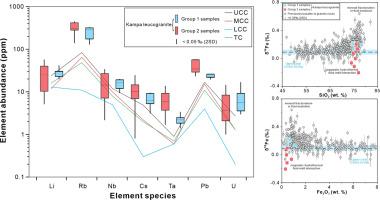Iron isotopic fractionation by magmatic-hydrothermal fluid-melt interaction in the Himalayan leucogranites
IF 6.3
3区 综合性期刊
Q1 Multidisciplinary
引用次数: 0
Abstract
Iron (Fe) isotopes have been used to trace magmatic evolution (e.g., mineral fractional crystallization, partial melting degree, and fluid exsolution), but the behavior of Fe isotopes in magmatic-hydrothermal processes remains poorly constrained. Here we report Fe isotope compositions of the Kampa leucogranites from the Himalayan orogenic belt to understand the fluid-melt interaction and rare metal enrichment in highly-evolved granites. The Nb/Ta ratio divides samples into two groups: group 1 with high Nb/Ta ratios while group 2 with low Nb/Ta ratios. The δ56Fe of group 1 leucogranites range from 0.14‰ to 0.23‰, isotopically heavier than the average upper continental crust value, indicative of the residues from fractional crystallization. On the contrary, the group 2 leucogranites exhibit large range of δ56Fe from −0.21‰ to 0.21‰. The correlations between fluid-mobile/fluid-immobile element ratios, and iron isotope, and tetrad effect were attributed to the effect of magmatic-hydrothermal fluid-melt interaction during magma evolution. A fluid-melt interaction model with an initial δ56Fe of -0.4‰ for the fluid and a fractionation factor Δ56Fefluid-melt of −0.35‰ successfully explains the observed Fe isotope data. It is likely that these magmatic-hydrothermal fluids are derived from exsolution from the underlying magma reservoirs in the middle crust, which can modify the Fe isotope compositions and bring abundant rare metal elements into the leucogranites. Therefore, Fe isotope data can reveal the properties of magmatic-hydrothermal fluids and serve as an indicator for ore-forming processes.

喜马拉雅浅长花岗岩中岩浆-热液-熔体相互作用的铁同位素分选
铁(Fe)同位素已被用于追踪岩浆演化(如矿物的分离结晶、部分熔融程度和流体的析出),但铁同位素在岩浆-热液过程中的行为仍然缺乏约束。本文报道了喜马拉雅造山带坎帕浅花岗岩的铁同位素组成,以了解高演化花岗岩的流体-熔体相互作用和稀有金属富集。Nb/Ta比值将样品分为两组:高Nb/Ta比值组1和低Nb/Ta比值组2。第1组蓝花岗岩体δ56Fe值在0.14‰~ 0.23‰之间,同位素重于上大陆地壳平均值,为分馏结晶残余。相反,2组蓝花岗岩体δ56Fe值在−0.21‰~ 0.21‰范围较大。岩浆演化过程中岩浆-热液-熔体相互作用的影响导致了可动/不可动元素比值与铁同位素、四分体效应的相关性。流体初始δ56Fe为-0.4‰,分馏因子Δ56Fefluid-melt为- 0.35‰,流体-熔体相互作用模型成功解释了观测到的Fe同位素数据。这些岩浆热液可能来源于中地壳下伏岩浆储层的出液,这些岩浆热液可以改变铁同位素组成,将丰富的稀有金属元素带入浅花岗岩。因此,铁同位素数据可以揭示岩浆热液流体的性质,并作为成矿过程的指示物。
本文章由计算机程序翻译,如有差异,请以英文原文为准。
求助全文
约1分钟内获得全文
求助全文
来源期刊

Fundamental Research
Multidisciplinary-Multidisciplinary
CiteScore
4.00
自引率
1.60%
发文量
294
审稿时长
79 days
期刊介绍:
 求助内容:
求助内容: 应助结果提醒方式:
应助结果提醒方式:


